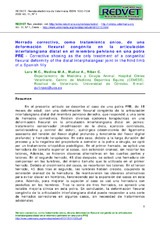Mostrar el registro sencillo del ítem
Herrado correctivo, como tratamiento único, de una deformación flexural congénita en la articulación interfalangiana distal en el miembro pelviano en una potra PRE
| dc.contributor.author | Lara, M.C. | |
| dc.contributor.author | Medina, M.A. | |
| dc.contributor.author | Muñoz, A. | |
| dc.contributor.author | Riber, C. | |
| dc.date.accessioned | 2012-11-02T09:55:17Z | |
| dc.date.available | 2012-11-02T09:55:17Z | |
| dc.date.issued | 2009 | |
| dc.identifier.uri | http://hdl.handle.net/10396/8157 | |
| dc.description.abstract | En el presente artículo se describe el caso de una potra PRE, de 18 meses de edad, con una deformación flexural congénita de la articulación interfalangiana distal del miembro pelviano derecho, que respondió a una serie de herrados correctivos. Existen diversas opciones terapéuticas en una deformación flexural en la articulación interfalangiana distal en potros: tratamiento conservador (modificación de la dieta, ejercicio controlado, oxitetraciclina y control del dolor), quirúrgico (desmotomía del ligamento accesorio del tendón del flexor digital profundo y tenotomía del flexor digital profundo) y herrado terapéutico. En este caso, debido a la larga duración del proceso y a la negativa del propietario a someter a la potra a cirugía, se optó por un tratamiento ortopédico podológico. En el primer herrado, se aplicó una herradura de tamaño superior al casco, con extensión craneal, sin recortar los talones. Además, se hicieron claveras alternativas en las cuartas partes y talones. En el segundo herrado, 45 días después, se colocó una herradura sin compensar en las lumbres, del mismo tamaño que la utilizada en el primer herrado. Debido al crecimiento del casco, se recortaron los talones. En el tercer herrado, 45 días tras el segundo, las lumbres habían crecido, ocupando la extensión craneal de la herradura. Se mantuvieron las claveras alternativas para evitar clavar en hombros, favoreciendo así la expansión del casco en esta zona. Además, para mejorar la sujeción al caso se usó una herradura con pestañas en los hombros. Tras la serie de tres herrados, se apreció una notable mejoría clínica en esta potra. En conclusión, la deformación flexural congénita de la articulación interfalangiana distal puede responder a una serie de herrados correctores en algunos casos, sin necesidad de tratamientos adicionales. | es_ES |
| dc.description.abstract | In the present article, we describe a congenital flexural limb deformity affecting the distal interphalangeal joint of the right hind limb in an 18-months old Spanish filly which positively responded to serial corrective shoeing procedures. There are different therapeutic options for the treatment of flexural limb deformity in the distal interphalangeal joint in horses: conservative treatment (changes in diet, controlled exercise intensity, oxytetracycline and medical pain management), surgical (inferior check ligament desmotomy and deep digital flexor tenotomy) and therapeutic shoeing. In the case presented here, because of the long duration of the process and because the owner refused the surgical option, we selected the orthopedic shoeing. In the first shoeing, we used a shoe bigger than the hoof, with cranial toe extensions. Additionally, we use alternative nail holes in quarters and heels. In the second shoeing, carried out 45 days after the first shoeing, we used a non-compensated shoe of the same size those used in the first shoeing. Furthermore, and because of the growth of the hoof, the heels were lowered. In the third shoeing, performed 45 days after the second, we observed that the toe grew up in the cranial toe extensions. We kept the alternative nail holes in order to avoid the holes in the toes promoting the growth of the hoof in the toes. Moreover, and in order to hold better the shoe, we applied with clicks in the toes. After 3 shoeing procedures, the filly underwent a marked improvement. It is concluded that a congenital flexural deformity affecting the distal interphalangeal joint might favorably respond in some cases to a series of corrective shoeing procedures without the necessity of additional treatments. | es_ES |
| dc.format.mimetype | application/pdf | es_ES |
| dc.language.iso | spa | es_ES |
| dc.publisher | Veterinaria.org | es_ES |
| dc.rights | https://creativecommons.org/licenses/by-nc-nd/4.0/ | es_ES |
| dc.source | REDVET. Revista electrónica de veterinaria 11 (1), 1-7 (2009) | es_ES |
| dc.subject | Caballos | es_ES |
| dc.subject | Cojeras | es_ES |
| dc.subject | Herrado | es_ES |
| dc.subject | Horses | es_ES |
| dc.subject | Lameness | es_ES |
| dc.subject | Shoeing | es_ES |
| dc.title | Herrado correctivo, como tratamiento único, de una deformación flexural congénita en la articulación interfalangiana distal en el miembro pelviano en una potra PRE | es_ES |
| dc.title.alternative | Corrective shoeing as the only treatment of a congenital flexural deformity of the distal interphalangeal joint in the hind limb of a Spanish filly | es_ES |
| dc.type | info:eu-repo/semantics/article | es_ES |
| dc.relation.publisherversion | http://www.veterinaria.org/revistas/redvet/n010110.html | |
| dc.rights.accessRights | info:eu-repo/semantics/openAccess | es_ES |

